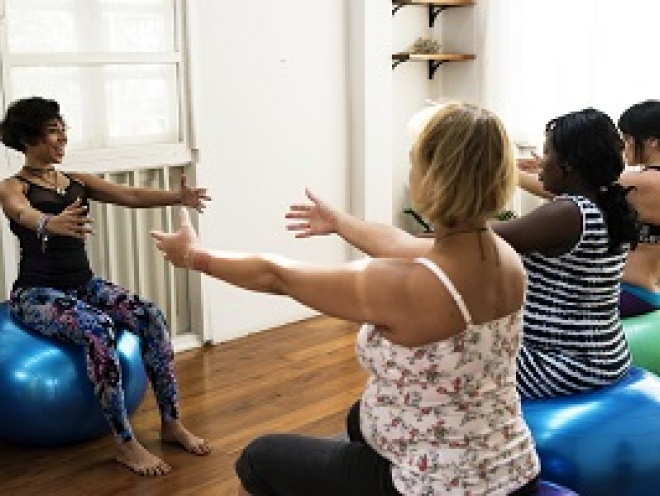You could fit into your daily routine some strengthening exercises where it can make a massive difference - your stomach and pelvic floor. Here's how.
Stomach strengthening exercises can make a real difference. They improve circulation, ease backache and make joints stronger. All of which helps you to feel at your best.
Doing pelvic floor muscle exercises (Kegels) from early pregnancy onwards can stop those accidental wees in late pregnancy and within six months of childbirth. Pelvic floor exercises can also prevent prolapse, which is where the pelvic organs drop down into the vagina (Hay-Smith and Dumoulin, 2006; Hay-Smith et al, 2008; Pelaez et al, 2013).
What is the pelvic floor?
Your pelvic floor is the layered muscle that stretches like a hammock from the front of your pelvis to the bottom of your backbone. Pregnancy and childbirth puts a strain on these muscles (NHS Choices, 2017).
"It is quite common to leak wee when coughing, sneezing or straining during pregnancy if you have weak pelvic floor muscles. It’s known as stress incontinence."
Stress incontinence can carry on after pregnancy yet doing pelvic floor exercises can help reduce or help you avoid having this issue (Boyle et al, 2012; NHS Choices, 2017).
If you’re young and not experiencing stress incontinence, pelvic floor exercises are also hugely beneficial during pregnancy. The best thing is to fit the exercises into your daily routine, perhaps when you’re watching telly or just before you climb into bed (NHS Choices, 2017). Here’s what you need to do.
Stomach muscle exercises
- Start on all fours, making sure your knees are under your hips and hands are under your shoulders. Have your fingers facing forwards and abdominal muscles lifted to help keep your back straight.
- Pull in your stomach muscles and raise your back towards the ceiling, letting your head gently relax forwards. Don’t let your elbows lock.
- Hold this for a few seconds and then return to the original position.
- Take care not to hollow your back. Your back should always return to the straight, neutral position.
- Do this rhythmically 10 times, making your muscles work hard and moving your back carefully.
- Only move your back as far as you can while still feeling comfortable.
Pelvic tilt exercises
- Stand with your shoulders and bottom against the wall, keeping your knees soft.
- Pull your belly button towards your spine so your back flattens against the wall, hold for four seconds and release.
- Repeat 10 times.
Pelvic floor exercises
- Close your anus like when trying to stop yourself from doing a poo. Meanwhile, draw your vagina upwards like you’re gripping a tampon or stopping a wee with your muscles.
- Do this quickly to begin with, tightening and immediately releasing the muscles. Then do it slowly, holding the contractions for as long as you can before you relax. Try to hold for 10 seconds. Repeat nine squeezes.
- Try to do three of these sessions every day.
- (Boyle et al, 2012; NHS Choices, 2017)
As well as these exercises, practice tightening up the pelvic floor muscles before and during coughing and sneezing.
Slow squeeze pelvic floor exercises
This exercise helps to support your pelvic organs through your pregnancy. It might be tricky at first to hold this squeeze for a long time. Try to build up the length of the hold and release the squeeze slowly.
- Lift your pelvic floor muscles upwards and inwards, slowly tightening them.
- Continue lifting from your pelvis up into your belly.
- Hold for four seconds and release it slowly.
- If it’s difficult to hold the squeeze for this long and you have nothing left to release, hold for a shorter time to begin with. Don’t worry, you can increase the hold length bit by bit until you manage a four second hold.
- Try to keep some of the squeeze left to release so you can release it slowly when you finish the exercise. Do five squeezes at a time
- Repeat this five times a day. It will get easier.
- (Tommy’s, 2017)
This page was last reviewed in October 2017.
Further information
Our support line offers practical and emotional support with feeding your baby and general enquiries for parents, members and volunteers: 0300 330 0700.
We also offer antenatal courses which are a great way to find out more about birth, labour and life with a new baby.
Make friends with other parents-to-be and new parents in your local area for support and friendship by seeing what NCT activities are happening nearby.
Boyle R, Hay-Smith EJ, Cody JD, Mørkved S (2012). Pelvic floor muscle training for prevention and treatment of urinary and faecal incontinence in antenatal and postnatal women. Cochrane Database Syst Rev. 10:CD007471. doi: 10.1002/14651858. Available from https://www.ncbi.nlm.nih.gov/pubmed/23076935 [Accessed 17 April 2018].
Hay-Smith EJ, Dumoulin C. (2006) Pelvic floor muscle training versus no treatment or urinary and faecal incontinence in antenatal and postnatal women. Cochrane Database Systemic Review. Available from: https://www.ncbi.nlm.nih.gov/pubmed/16437536 [Accessed 17 April 2018].
Hay-Smith J, Mørkved S, Fairbrother KA, Herbison GP. (2008) Pelvic floor muscle training for prevention and treatment of urinary and faecal incontinence in antenatal and postnatal women. Cochrane Database Systematic Review. (4):CD007471. doi: 10.1002/14651858. Available from: https://www.ncbi.nlm.nih.gov/pubmed/18843750 [Accessed 31 October 2018].
NHS Choices. (2017) Exercises in pregnancy. Available from: https://www.nhs.uk/conditions/pregnancy-and-baby/pages/pregnancy-exercise.aspx [Accessed 31 October 2017].
Pelaez M, Gonzalez-Cerron S, Montejo R, Barakat R (2013) Pelvic floor muscle training included in a pregnancy exercise program is effective in primary prevention of urinary incontinence: a randomized controlled trial. Neurology and Urodynamics. 33(1):67-71. doi: 10.1002/nau.22381. Available from: https://www.ncbi.nlm.nih.gov/pubmed/23389863 [Accessed 31 October 2017].
Tommy’s. (2017) Pelvic floor exercises. Available from: https://www.tommys.org/pregnancy-information/im-pregnant/exercise-pregnancy/pelvic-floor-exercises [Accessed 17 April 2018].
Further reading
Association of Chartered Physiotherapists in Women’s Health. (2010) Aquanatal guidelines: antenatal and postnatal exercises in water. Available from: www.acpwh.org.uk [Accessed 19 October 2017].
Balogh A (2008) Pilates and pregnancy Midwives Magazine. Available from: https://www.rcm.org.uk/news-views-and-analysis/analysis/pilates-and-pregnancy [Accessed 17 April 2018].
Cameron, J. Millar, K. (2014) Guidelines for teaching yoga to pregnant women. Available from: http://www.yogascotland.org.uk/wp-content/uploads/2014/01/Yoga-Scotland-Pregnancy-Guidlines_July2014.pdf [Accessed 17 April 2018].
Department of Health. (2017) Physical activity for pregnant women. Available from: https://www.gov.uk/government/uploads/system/uploads/attachment_data/file/622335/CMO_physical_activity_pregnant_women_infographic.pdf [Accessed 16 October 2017].
Evenson, K. Savitz, D. Huston, S. (2004) Leisure-time physical activity among pregnant women in the US. Paediatric and Perinatal Epidemiology. 18(6): 400-407. Available from Available from https://www.ncbi.nlm.nih.gov/pubmed/23076935 [Accessed 17 April 2018].
Midwives Magazine. (2005) Pilates and pregnancy. Available from: https://www.rcm.org.uk/news-views-and-analysis/analysis/pilates-and-pregnancy [Accessed 31 October 2017].
Nascimento SL, Surita FG, Cecatti JG. (2012) Physical exercise during pregnancy: A systematic review. Current Opinion in Obstetric and Gynecology. 24(6):387-394 Available from: https://www.ncbi.nlm.nih.gov/pubmed/23014142 [Accessed 31 October 2018].
Natural England Commissioned Report. (2016) A review of nature based interventions for mental health care. Available from: http://publications.naturalengland.org.uk/publication/4513819616346112 [Accessed 17 October 2018].
Swim England. (2015) Swimming when pregnant. Available from: http://www.swimming.org/learntoswim/swimming-when-pregnant/ [Accessed 30 October 2017].
Van Hook JW, Gill P, Easterling TR, Schmucker B, Carlson K, Benedetti TJ. (1993) The hemodynamic effects of isometric exercise during late normal pregnancy. AJOG 169(4): 870-873 Available from: https://www.ncbi.nlm.nih.gov/pubmed/8238141 [Accessed 31 October 2017].
Zavorsky, GS. Longo LD. (2011) Adding strength training, exercise intensity and caloric expenditure to exercise guidelines in pregnancy. Obstetrics and Gynecology. 117(6): 1399-1402. Available from: https://www.ncbi.nlm.nih.gov/pubmed/21606752 [Accessed 31 October 2017].




